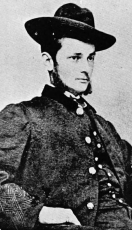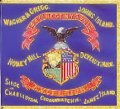By mid-1864, the last full year of the war, the tide had turned distinctly against the Confederacy. Sherman had begun the campaign to take Atlanta and march to the sea. But Charleston had yet to be taken. And the largest battle fought on Johns Island was about to begin. As part of the effort to take Charleston, Union forces began an offensive that would engage forces on James and Johns Island as well as on the mainland up the North Edisto River.
Strategy

Typical Civil War locomotive
Click to Enlarge
The railroad between Savannah and Charleston was the main route for supplies and reinforcements into the city of Charleston. Despite numerous attempts to cut it earlier in the war, it remained intact. The recently appointed commander of the Union’s Department of the South, Major General John Foster, decided to launch a major offensive against Charleston in July 1864. The objective was to capture James Island and to engage Southern forces to prevent them from participating in actions in other theaters.
The offensive was planned in three parts. The main effort was an assault on James Island including an amphibious landing at Fort Johnson. The second was a landing at White Point on the North Edisto River across from Wadmalaw Island. The third attack was a landing on Seabrook Island and then march up Bohicket Road on Johns Island. Both these landings were aimed at cutting the railroad to prevent Rebel reinforcements from participating in the main battle on James Island. The Johns Island effort was aimed at the railroad bridge on the mainland at Rantowles Creek (1.5 miles west of Main Rd. on today’s Savannah Highway / Rt. 17).
Landing on Seabrook Island

Col Slidell, commander of the 144th NY was only 26 at the time of the battle.
Click to Enlarge
The Union forces began landing on Seabrook Island on the morning of Saturday, July 2 1864 continuing into early the next day. The troops were under the command of Brigadier General John P. Hatch. They consisted of the following units:
- 104th Pennsylvania Volunteers, Colonel William H. Davis
- 144th New York Volunteers, Colonel W. J. Slidell
- 56th New York Infantry, Colonel Charles H. Van Wyck,
- 157th New York, Colonel Philip P. Brown, Jr.
- 26th New York Infantry (Colored), Colonel William Silliman
- 9th US Colored Regiment, Maryland Volunteers
- 3rd New York Artillery (4 guns), Captain Wildt’s
- 4th Massachusetts Cavalry (2 companies) , Maj. D. B. Keith
- Engineer Unit, Bridge Train
Altogether, there were about 5,000 Union troops.

Regimental Banner of the 144th NY
Click to Enlarge
On Saturday, July 2, the first regiment to land, the 144th New York, marched up Seabrook Island toward Haulover Cut while the other troops were still landing. They forded the Cut, drove off the Confederate pickets and secured the earthworks on the Johns Island side (where the Rosebank Farm Stand was located until recently). This opening action was similar to what occurred earlier in February at the Battle of Haulover Cut. However this time, the Confederates had fewer forces readily available and lacked the leadership of Captain Humphreys and Captain Jenkins who had commanded the first Rebels in the earlier battle. Now a Major, Jenkins still commanded the forces on Johns Island but was off the Island.
By Sunday morning, July 3, engineers repaired the bridge across the Cut and the additional Union regiments had been landed. Under the command of Col. Davis, they marched up Bohicket Road (today’s Betsey Kerrison Pkwy) to the Cocked Hat, at the intersection with River Road. Confederate reinforcements forces under the temporary command of Captain Edward L. Parker of the Marion Artillery had begun to gather but where still spread out between Church Flats on the mainland and the Episcopal Church near the bridge to Wadmalaw. There were also false reports of landings on Wadmalaw which made Capt. Parker cautious of moving too far forward.
Change of Plans
Major Davis sent scouts up Bohicket Road towards the Presbyterian Church where they engaged Confederate pickets. He was unsure of what opposition he faced and was wary from his side’s previous defeat in February. The day was hot and the Union forces were exhausted from the landing and march up to the Cocked Hat. So they entrenched and camped there for the night. Meanwhile, the Confederates realizing the large force they faced, burned down the Orange Hill Plantation house, about a mile north of the Union camp. This had been the headquarters of the Stono Brigade. It was said the fire could be seen as far away as Charleston, signaling the Union invasion.
By Monday morning, July 4, General Hatch had taken personal command of the Union troops. He had received reports that some Union reinforcements, including artillery, had landed at Legareville on the east side of Johns Island. With the old plantation house smoldering on his front to the north up Bohicket Rd, and still unsure of the opposition he faced, Gen Hatch decided to change his plans and march east up River Rd. instead. While unable to attack the railroad in that direction, he could support the landings on James Island and threaten the Confederate flank there. He would also have better access to reinforcements and additional supplies as well as an escape route from Legareville along the Stono River. The uncontested controlled of the navigable waterways by the Federal Navy was a key element in all actions in the lowcountry.
July in the Lowcountry
Despite having set off at 5 AM, by noon the Union troops had only gone 5 miles up to Brickhouse Plantation at Legareville Rd. (approximately where today’s Bryan Dairy Road is located). Image marching in the still of the lowcountry’s July heat in a woolen uniform on a dirt road behind hundreds of other pounding feet stirring up the dust. Major Davis reported “the men suffered severely from the dust and heat†and that “I do not remember a hotter day during my service, not even in Mexicoâ€. One soldier in the 144th New York recorded the day was marked by “the intense heat and the stifling dust and intolerable thirst “. On the brighter side he also wrote â€One compensation was found in the ripe, juicy plums which at our frequent stops could be had for the reaching.†While a heavy rain in the midafternoon cooled things off a bit, the now muddy roads made any further progress impossible that day. The Union forces camped there for the night, too exhausted for much of an Independence Day celebration.
The most notable event of the day was the capture of Union surgeon Dr. William T. Robinson. Doctor Robinson was with Company G of the 104th Pennsylvania Regiment who through some confusion missed the turn at River Rd. and continued up Bohicket Rd. After going a mile or so, Captain Corcoran of Company G realized his error and halted. The doctor, convinced the regiment was just ahead, insisted on continuing a bit further where he was captured by some Confederate pickets. After a short engagement with the Confederates, Captain Corcoran’s unit retreated back down Bohicket Rd. where he rejoined the main force.
After his capture Surgeon Robinson was brought to the Charleston jail and interrogated by the Confederate adjutant, Major Charles S. Stringfellow (coincidently sharing the same surname as Johns Island historian Elizabeth “Betty†Stringfellow, but no relation.). Nevertheless he reported his treatment as “universally kind and respectfulâ€. Almost immediately Union General Foster wrote the Confederate commander, General Sam Jones, seeking repatriation of the surgeon as a medical officer. In the middle of ongoing active combat over the next few weeks, the generals exchanged a polite correspondence over the ‘proprieties’ of war. Eventually Doctor Robinson was exchanged in August for a Confederate medical officer.
Other Actions
Meanwhile, on July 2 thru 4, the actions on James Island and up the Edisto River had proceeded. The tricky night time amphibious assault on Fort Johnson was beset by problems. Nevertheless one unit of the 52nd Pennsylvania reached the parapet of the lightly defended Fort Johnson. But in the confusion the other scattered units had retreated, and being unsupported, the Pennsylvanians surrendered, not realizing that even their small group outnumbered the opponents within the fort.
Another Union force had attacked James Island from Sol Legare Island on July 2. But making little head way, they retreated back on the 3rd. The Union Navy repeatedly shelled the Confederate batteries on James Island from the Stono River but with little apparent success. The Edisto expedition met stiff opposition on Younges Island and also retreated without ever reaching the railroad or causing any significant damage.
Next Time – Three Days of Battle
By the morning of July 5, 1864, two of the three Federal attacks in the lowcountry had failed. But on Johns Island a strong force was half way up the Island facing scattered, disorganized Confederate opposition. The Federal Navy had full control of the Stono River to support them. The Union was in a good position to take most of the east side of Johns Island and flank the enemy on James Island, threatening Charleston. Next post: three days of battle determines the outcome.

 Growing a New Johns Island - Back to the Future
Growing a New Johns Island - Back to the Future